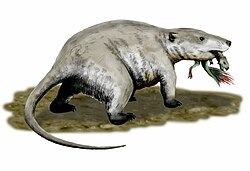Repenomamus
Repenomamus is the largest known mammal from the Cretaceous period. Its fossil was found in Manchuria.
| Repenomamus Temporal range: Lower Cretaceous
| |
|---|---|

| |
| Repenomamus giganticus skull | |
| Scientific classification | |
| Kingdom: | |
| Phylum: | |
| Class: | |
| Order: | |
| Suborder: | |
| Family: | Repenomamidae Li, Wang, Wang, Li, 2000
|
| Genus: | Repenomamus Li, Wang, Wang, Li, 2000
|
There is good evidence that it fed on dinosaurs. It is not known whether Repenomamus was a hunter or a scavenger.
Life style
Repenomamus was carnivorous. A specimen of R. robustus has been discovered with the fragmentary skeleton of a juvenile Psittacosaurus preserved in its stomach.[1]
This is the strongest evidence that Mesozoic mammals fed on dinosaurs, though there were earlier indications of this.[2]
The larger species, R. giganticus, is the largest mammal known from the Cretaceous. R. giganticus was more than 1 metre (39 inches) long and weighed about 12–14 kg (26–31 lb). Its skull measures 16 cm (6.25 in) long, its body 52 cm (20.5 in), and the preserved part of its tail 36 cm (14 in).
Discovery
The fossils were recovered from the lagerstätte of the Yixian Formation in the Liaoning Province of China, renowned for its extraordinarily well-preserved fossils of feathered dinosaurs. They have been dated to 130 million years ago, during the Lower Cretaceous period.[3]
Repenomamus is a genus of triconodonts, a group of mammaliaformes with no modern relatives.
Repenomamus Media
R. robustus specimen with Psittacosaurus remains in its stomach, Paleozoological Museum of China.
References
- ↑ Yaoming Hu, Jin Meng, Yuanqing Wang, Chuankui Li (2005). "Large Mesozoic mammals fed on young dinosaurs" (PDF). Nature. 433 (7022): 149–152. Bibcode:2005Natur.433..149H. doi:10.1038/nature03102. PMID 15650737. S2CID 2306428.
{{cite journal}}: CS1 maint: multiple names: authors list (link) - ↑ Elzanowski, Andrzej & Wellnhofer, Peter. 1993. Skull of Archaeornithoides from the Upper Cretaceous of Mongolia. American Journal of Science. 293-A-A, 235-252
- ↑ J. Li; et al. (2001). "A new family of primitive mammal from the Mesozoic of western Liaoning, China". Chinese Science Bulletin. 46 (9): 782–785. Bibcode:2001ChSBu..46..782L. doi:10.1007/BF03187223. ISSN 1001-6538. S2CID 129025369. Archived from the original on 2011-05-14.



